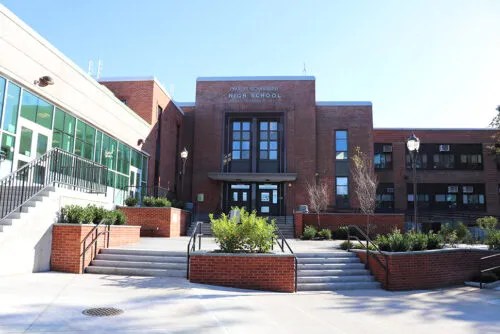Ospreys, also known as sea hawks, are beginning to
migrate and group sets up nests to welcome them

On Saturday, March 26, a group of people went down to the end of Hoffstot Lane in Sands Point to erect an osprey nest in the marsh. Jim Jones, a retired biology teacher who now works at Bethpage State Park, and is a member of the Osprey Protection Team at PSE&G Long Island, gathered a small group to put up a new osprey platform.
A tall osprey perch and platform stood in the marsh surrounding the cul de sac at the end of Hoffstot Lane. Over a year ago, a storm took the structure down. A person who owns property in the cul de sac spread the word about the incident, hoping someone who knew about the birds could help replace the fallen structure. Luckily, Jones was notified.
“I went to check it out. It’s easy to build the platform,” said Jones. “The ospreys aren’t really picky, so I have a plan I’ve been using for years. It’s all pressure-treated lumber and you bolt it together. With a 20-foot long center pole, and a platform with a perch on top, the osprey can drop their sticks.”
It takes Jones a couple of hours to put the nest platforms together, and then he has to get a couple of people together to carry the structure out. The wooden nest structures weigh a couple of hundred pounds, so it requires help.
“We waited till the start of spring to bring the platform out,” said Jones. “It has to be at the right time in terms of low tide. On the day we brought the platform out, low tide was at 7 a.m. and we had good weather. It was a lot of fun and we got it done in about an hour.”
Now that the warm weather is coming back to Long Island, the migratory birds will start returning from the south. Jones has noticed that some of the nests erected in the Bayville area are already filled with ospreys, and predicts that within the next two weeks more ospreys will be making their way back.
“Because of things like the Endangered Species Act, the osprey population on Long Island is growing,” said Jones. “Back in the ’40s and ’50s the use of DDT almost wiped the birds out.”
The chemical DDT was popularly used as an insecticide until studies concluded that the chemical was harmful to people, animals and the environment.
“Once the legislation was passed they banned various chemicals like DDT,” said Jones. “Then it became a matter of leaving the ospreys alone and hoping they come back. But what people found out is you could encourage the birds because they love a nest near the water, they love fish and they like tall isolated structures.”
While there are many isolated and tall trees on Long Island, many of the tall, isolated trees near the shores have been cut down to make room for homes. So building the platform structures and placing them in marsh areas near the shores has proven to be a productive way at encourag more ospreys to make their homes on Long Island.
“It was such an enjoyable experience,” said Jones about the early morning journey on the marsh. “I’ve been doing this for years now and it’s nice to get other people involved.”
Jones, and many other residents who enjoy bird watching, are looking forward to having the osprey birds return to the Long Island shores over the next few weeks.































